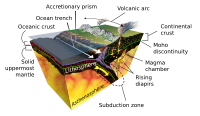
Photo from wikipedia
Trench basin, as an important sedimentary repository in oceanic subduction zones, documents faithfully the evolution of paleodrainage and paleogeographic information. Because of the frequent intense deformation during and after deposition,… Click to show full abstract
Trench basin, as an important sedimentary repository in oceanic subduction zones, documents faithfully the evolution of paleodrainage and paleogeographic information. Because of the frequent intense deformation during and after deposition, the recognition of trench-basin strata in orogenic belts is quite challenging. Several trench-fill deposits have been identified from the Yarlung Zangbo suture in southern Tibet, which can be classified into two types based on major differences in formation timing and tectonic setting. The first type developed during subduction of the Neotethyan oceanic slab in the Cretaceous (e.g., the Jiachala, Rongmawa, and Luogangcuo formations), and the second type developed during the initial stage of the India-Asia collision in the Palaeogene (e.g., the Sangdanlin-Zheya formations). The former was originally deposited on the subducting oceanic crust and then accreted as tectonic slices into the subduction complex; the latter was deposited unconformably on the continental margin of the subducting Indian plate and then involved in the subduction complex during the continental collision. Typical lithologies of trench-basin fills include abyssal chert, siliceous shale, silty to sandy turbidites, debris flows deposits, and slump deposits without carbonate. Detritus feeding these basins were chiefly from the uplifted terrane in the upper plate. This paper summarizes the geological features of trench basins developed in southern Tibet and proposes criteria for recognizing trench-basins in collisional orogens.
Journal Title: Science China Earth Sciences
Year Published: 2020
Link to full text (if available)
Share on Social Media: Sign Up to like & get
recommendations!